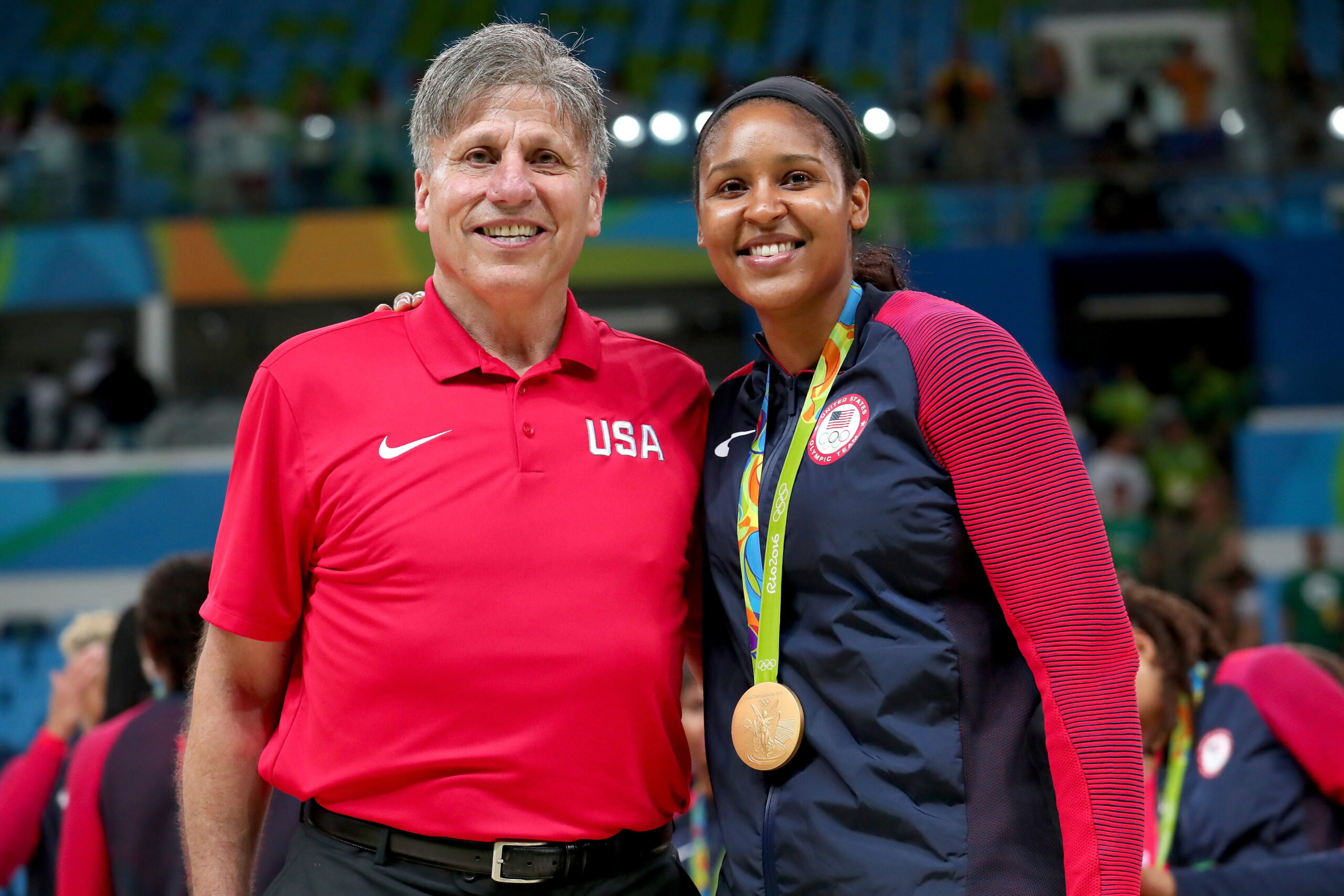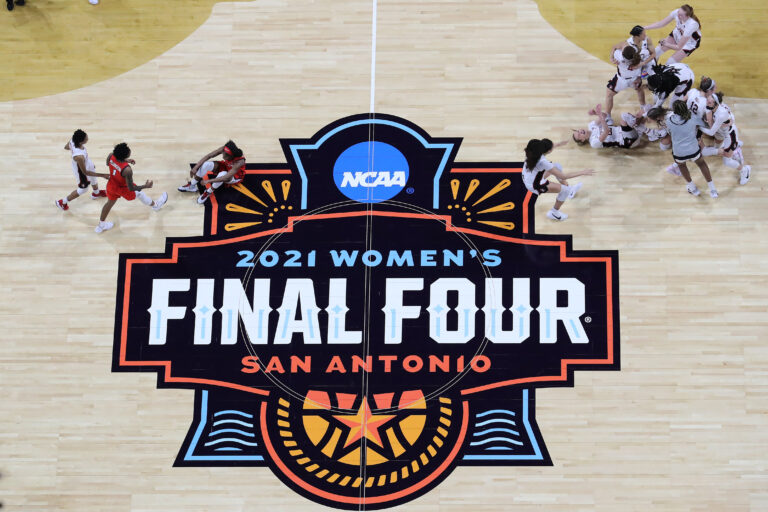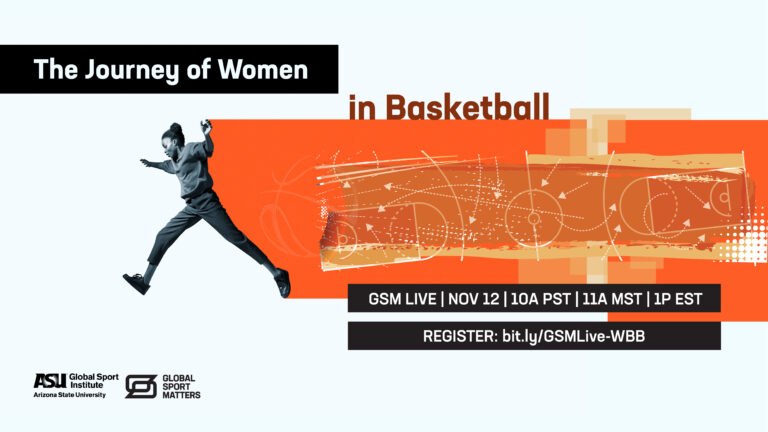As Women’s Basketball Grows, Doug Bruno Wants To ‘Naturally Move It Forward’
Why this matters
New Field Study data from the Global Sport Institute show that since the implementation of Title IX, the proportion of women coaches and coaches of color in NCAA women’s basketball have not meaningfully changed.
As the sport draws greater popularity and investment, men like DePaul head coach Doug Bruno are listening to the message of women in the sport and working to create a pipeline for a new generation of women coaches to take over.
Doug Bruno was fresh out of college and working in athletics administration at DePaul University when he got an order he didn’t expect: Go coach the women’s basketball team.
It was 1975, and Bruno, a DePaul basketball alum, had been coaching high school boys for two seasons. He was 25. But his boss at the university had a problem: The school’s part-time women’s basketball coach at the time, Debbie Miller, had scheduled a vacation for the middle of the season. Someone, anyone, needed to command the bench for the Blue Demons. So Bruno reported for duty.
“You know, I was thrust into it,” Bruno says. “And I never asked to be educated, but I was educated, because I had to fight for practice time, to fight for uniforms. I’m fighting for how to get to games, fighting for games, and then, all of a sudden, you start understanding how hard the fighting is for the (women) in our society.”
Today, only three coaches in National Collegiate Athletic Association Division I women’s basketball – Harvard University’s Kathy Delaney-Smith, the University of Connecticut’s Geno Auriemma, and Stanford University’s Tara VanDerveer – have held their jobs longer than Bruno. He spent two years in his first stint with the DePaul women, then left for a decade to coach in the Women’s Professional Basketball League and as an assistant for the Loyola University Chicago men’s team. In 1988, he returned to the Blue Demons for good
Bruno tells stories of driving his players across the state in a van he bought for the occasion, so they could make it to each matchup on their schedule. He laughs about how far Illinois stretches and groans at the McDonald’s meals they ate on each trip. But as the years passed, Bruno got more resources, and he made use of them. He now has led the Blue Demons to more than 700 victories and 24 NCAA Tournaments. Along the way, he’s thought extensively about what his role is as a White man in a diverse women’s sport and how the fight for equality has both changed and remained constant.
“My job is to grow and develop female leadership,” he says, pointing out that although men like himself often receive opportunities to coach women’s college basketball, female coaches rarely receive the same within the men’s game. “And female leadership means to be head coaches of women's basketball teams.”
A new study conducted by the Global Sport Institute at Arizona State University of head coach hiring in women’s college basketball from 1984 to 2020 paints a mixed picture of that leadership. Although the coaching ranks feature a decent amount of gender equity, men and White women hold a disproportionate number of jobs relative to a Division I player population that is roughly 42 percent Black, and coaches of color, particularly women, continue to face barriers to career advancement.
Examining hiring patterns over five-year increments at schools in the NCAA Power 5 conferences as well as Historically Black Colleges and Universities (HBCUs), the study found that:
- From 1983 to 2020, women made up about 70 percent of outgoing and incoming head coaches, while men made up about 30 percent.
- In that same time period, 60 percent of outgoing and incoming women coaches were White, and 40 percent were Black. The same ratio held for male coaches.
- Only one Latinx coach held a head coach job in the study’s three decades of scope.
- The greatest percentages of men hired into head coaching positions occurred from 1984 to 1990 (20 percent) and from 2011 to 2015 (19 percent).
- Seventy percent of White head coaches were NCAA head coaches in their previous stops, compared with only 30 percent of Black head coaches. In addition, 20 percent of White head coaches were NCAA assistant coaches at their previous stop, compared with 50 percent of Black coaches.
- More White head coaches (22 percent) did not play basketball at any NCAA level than Black head coaches (17 percent). In addition, more Black head coaches (63 percent) played Division I basketball compared to their White peers (48 percent).
- Outgoing Black coaches were more likely to find their next jobs in high schools or athletics administration than their White colleagues, whereas outgoing White coaches were more likely to make lateral moves or to retire.
Women’s college basketball is at a crossroads. The NCAA, facing widespread criticism of its marginalization of the women’s game, is increasing its investment, and viewership and ticket sales for the women’s tournament are on a rapid upward trajectory. Will more resources and prominence have an impact on which coaches want jobs – and who gets them?
‘Wow, I Didn’t Know Women Could Do That’
When Bruno began his first coaching stint with DePaul, Title IX – the federal civil rights law prohibiting sex-based discrimination in schools or education programs receiving federal funding – had been in effect for barely three years. The school’s women’s basketball program was in just its second year of existence.
Bruno, who had graduated from DePaul in 1973, had no context for what he was walking into. But he remembers his first practice keenly. “The second I started coaching the women, it hit me immediately upside the head that gender has nothing to do with the inner competitiveness of an athlete,” he says.
Today, that statement is hardly revolutionary. But at the dawn of Title IX, women’s college basketball was a blank slate, a mystery, even a burden for many athletic departments, which were largely run by men for men. After Miller left DePaul in 1976, the administration didn’t look far for her replacement. Bruno was the guy, and he added the women’s team to his growing list of responsibilities: overseeing ticket sales and facilities, doing color for men’s hoops, and now coaching a team of his own.
“I made the mistake of asking [my boss], am I going to get paid anything extra?” Bruno recalls. “And he just blasted me and said ‘No, you're not going to get paid.’”
Related: Hey, Disruptors! Women’s Basketball Needs You
When women’s college sports were treated as an afterthought, male coaches were few and far between: Before Title IX’s enactment in 1972, more than 90 percent of women’s teams across all sports were coached by women. But as more money and attention flowed into those same sports, men like Bruno became an increasingly common sight. In 1981, the number of NCAA women’s teams with a female head coach had dropped to 55 percent – and by 2017, that number had fallen even further, to roughly 40 percent.
Women’s basketball has surpassed that mark. In 2019, women made up 61 percent of all women’s college basketball coaches, down from a peak of 66 percent in the 2009-10 season but still a majority. That dip was due in part to a wave of male hiring from 2011 to 2015 that echoed a similar surge in the 1980s.
Many observers attribute that earlier wave to the time lag between Title IX’s passage and an influx of dollars into the sport. While there’s no single explanation for the more recent uptick in male hiring, Muffet McGraw, the former Notre Dame coach who led her team to nine Final Fours and two championships, believes that one reason stands out: College sports leadership – like most higher education leadership – is predominantly made up of men.
“There's so many things that you can do to change the narrative,” McGraw says, “but it comes down to athletic directors. They’ve got to hire somebody who, you know, doesn't look like them.”
In a wide-ranging 2019 interview with ThinkProgress, McGraw outlined the reasons she stopped hiring male assistants beginning in 2012. Before that, she’d always had on her staff one man, whom she saw as a vital link to male-dominated AAU leadership and scouting services. But after former Notre Dame star Beth Morgan Cunningham filled the vacant, once-reserved-for-a-man spot on McGraw’s staff, the coach saw no reason to turn back.
“All these millions of girls that play sports across the country, we’re teaching them great things about life skills, but wouldn’t it be great if we could teach them to watch how women lead?” McGraw said in a media session at the women’s Final Four that year. “When you look at men’s basketball, 99% of the jobs go to men. Why shouldn’t 100 or 99% of the jobs in women’s basketball go to women?”
McGraw, who retired in 2020, feels that hiring women exclusively sent a message to her players about their futures, about paths they might one day be able to take. “So many women after playing think like, wow, this really is something that I could do,” she says. “Because I can see somebody who's a mom … who is a leader, who's doing things that you want to do. … Everywhere you look, you see men. In politics, in Hollywood, you see men in business and CEOs. … It's a concentration of male leaders. So to see somebody that looks like you, it's almost like, wow, I didn't know that women could do that.”
‘We Need To Do a Better Job of Representing the Players’
A few months after McGraw made her now-famous remarks about hiring women, one of her longtime assistants, Niele Ivey, came to her with news: Ivey had just been offered a job on the Memphis Grizzlies’ bench. Ivey, who starred for McGraw at Notre Dame from 1997 to 2001, had just finished her 12th year as a Fighting Irish assistant, and McGraw was thrilled for her. She told the younger woman to take the job.
“She was so surprised, because she thought I wanted to keep her, which, of course I did,” McGraw recalls. “But I still think of the experience that you're getting, you're at the top of the game of basketball, you're going to learn so much. It's like professional development.”
Ivey became just the ninth woman to serve as an assistant coach in the National Basketball Association, and McGraw was thrilled at the invaluable experience the younger coach would surely get. At that point, no one at Notre Dame was speaking openly about McGraw’s successor, but McGraw says Ivey was certainly in the running. In the end, she spent only a year away from South Bend; when McGraw announced her retirement in April 2020, the job was Ivey’s.
Ivey was certainly qualified. But the hire was noteworthy not just because of Ivey’s NBA experience; she is also a Black woman in a job market where even the most qualified women who look like she does are overlooked and excluded.
“She got the job because of her ability,” McGraw says. “But I just think we need to do a better job of representing the players that are [in our locker rooms].”
About 40 percent of the incoming and outgoing coaches tracked during the GSI study period were Black, a number that is roughly representative of the overall percentage of Black Division I women’s basketball players. But those numbers drop sharply when HBCUs are removed from the picture. Among non-HBCU jobs, only 17 percent of incoming head coaches were Black – 36 women and five men. In other words: The most lucrative, influential jobs in women’s college hoops are, by and large, going to White men and women.
And the Black women who do land major jobs often only get one shot at the Power 5. Take Cheryl Miller, one of the most famous and respected women in basketball history. Her first college coaching job was at her alma mater, the University of Southern California. but in 2014, when she returned from a 14-year hiatus from coaching, she landed at Langston University, an HBCU. Cynthia Cooper-Dykes, another women’s basketball legend, is also coaching at an HBCU, Texas Southern; before that, she’d resigned from the USC job. Clearly, when it comes to lateral moves, HBCUs provide the majority of such opportunities to African-American women; of the 19 African-American women coaches who made lateral moves during the study’s time frame, 14 coached at HBCUs.
Meanwhile, 58 White women moved from one head coaching job to another, evidence that it remains harder to make lateral head-coaching moves as a Black woman than as a White one. Black women seem to face harsher standards in the job market than any other demographic group.
However these barriers to advancement – racism, sexism, a climate in which Black women feel discouraged from even exploring coaching careers – have been erected, the only way to fully eradicate them is to change hiring practices at every level of the coaching pipeline. Groups like the Women’s Basketball Coaches Association can lobby for diversity and lead initiatives to promote it, but, ultimately, it will require university presidents and athletic directors to rethink the way they conduct coaching searches, and it will require head coaches to build more representative and diverse staffs.
Related: A New Case for Diversity in College Sports
For McGraw, that meant publicly and privately advocating for women and nurturing a minority candidate as a successor. For Bruno, it means hiring women whom he hopes will one day push men like him out of the game. This season, Bruno’s staff consists of two white women and one Black woman. His video coordinator, director of basketball administration, administrative assistant, and graduate are all women, too, as is the associate athletics director who oversees the program. At Notre Dame, where McGraw’s legacy is still strong, all three of Ivey’s assistants are women. Two are Black.
Every hire counts. But change takes time. After all, as Bruno often says, he’s not simply going to give back his job. And someone like Auriemma isn’t likely to resign at UConn for the sake of gender equity. Future opportunities need to shift and open. Consider what Bruno told his son, Bradley, who served on his staff in recent seasons before departing for Southern Illinois University-Edwardsville – where he’s the only man on a staff led by one of Bruno’s former players. “My recommendation to … Bradley is, if you want to coach, coach the men,” Bruno says.
“All the men that are in the game right now, I'm not trying to be a person trying to drive us all out of the game,” he adds. “But [I want to] naturally move it forward. If the development of female leadership is what I do for a living, then why shouldn't that leadership take over the roles of head coaches of college women's basketball teams?”
Monthly Issue
Taking Charge in Women's Basketball
Across the world, basketball is relatively unique among team sports with the volume of women who play and coach in its ranks. Still, trends in the sport’s leadership don’t accurately reflect the athletes who put in the work each day on the court.
While a diverse crop of head coaches at HBCUs has not created a pipeline to the Power Five, new momentum behind women’s sports has helped carry women’s basketball to new heights. Can an exciting, outspoken generation of leaders in the sport turn it into a more equitable and popular avenue for women to thrive as leaders and athletes?





